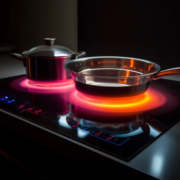The challenges of induction heating for cooktops: case study
Induction cooktops have changed the way we cook, promising fast, efficient, and precise heat control. But like every piece of technology, there are challenges that engineers are working to overcome. The main issue is energy transfer—the goal is to make sure that as much energy as possible from the electromagnetic coil directly heats the pan, not the surrounding air or other components.
In the world of induction heating, especially when developing cooktops and cookware such as pans, kettles, or other magnetic-compatible tools, engineers are faced with the challenge of optimizing energy transfer.
This process is important for improving performance, energy efficiency, and improving cooking experiences. With simulation software, engineers can visualize heat distribution, magnetic fields, and magnetic flux, identifying inefficiencies and areas for improvement. This use case will explore the challenges, solutions, and results based on real-world simulations used in the development of induction cooktops.
What is the challenge?
Induction heating operates by generating an electromagnetic field using a coil beneath the cooktop’s surface. This field interacts with the base of the cookware, creating heat directly in the material through eddy currents. However, several challenges can arise during this process:
- Uneven heat distribution: Often, the heat generated is concentrated in certain areas, leading to uneven cooking. For example, the center of the cookware may remain cooler than the edges, impacting cooking performance.
- Magnetic flux leakage: A significant amount of energy can be lost due to magnetic flux leakage, where the magnetic field escapes into the surrounding air rather than focusing entirely on the cookware.
- Coil design efficiency: The efficiency of the induction heating process heavily relies on the coil’s design. If the coil design does not adequately cover the pan’s base, heat distribution can be compromised, leading to inefficient cooking and wasted energy.
These are the core challenges that engineers must overcome to optimize induction heating for cooktops and cookware.
What is the Solution?
To address these challenges, engineers turn to simulation software to visualize and optimize heat distribution, magnetic field strength, and flux interactions. Below, we analyze several simulation images from CENOS Induction Heating simulation software that provide insight into the heat and magnetic behavior of the induction heating process.
Heat distribution simulation:
The following images demonstrate the temperature distribution across a pan heated by an induction cooktop. The heat is visualized using a color gradient, with blue indicating cooler areas and red to yellow representing hotter areas.
- Heat concentration in the pan: The simulation shows that the heat distribution is uneven, with higher temperatures at the offset-middle of the pan (as indicated by the green line in the graph). The center remains relatively cooler, revealing inefficiencies in the coil’s ability to uniformly heat the pan’s base.
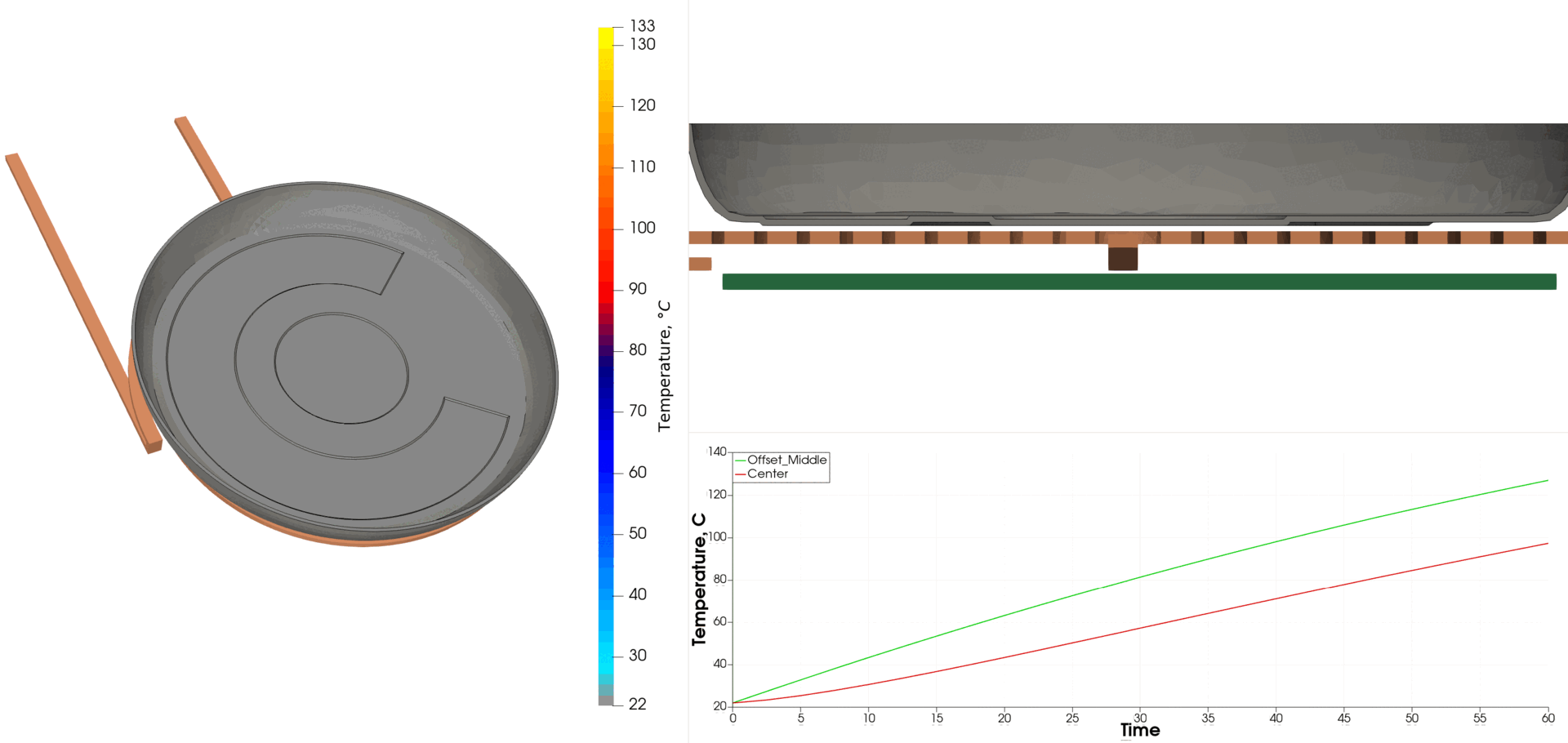
- Coil design impact on heat spread: Another image illustrates the impact of the coil’s design on temperature distribution. While the inner rings of the coil produce sufficient heat, the outer areas of the pan experience less heat transfer. This suggests that the coil’s design requires adjustment to ensure better heat distribution across the entire surface of the pan.
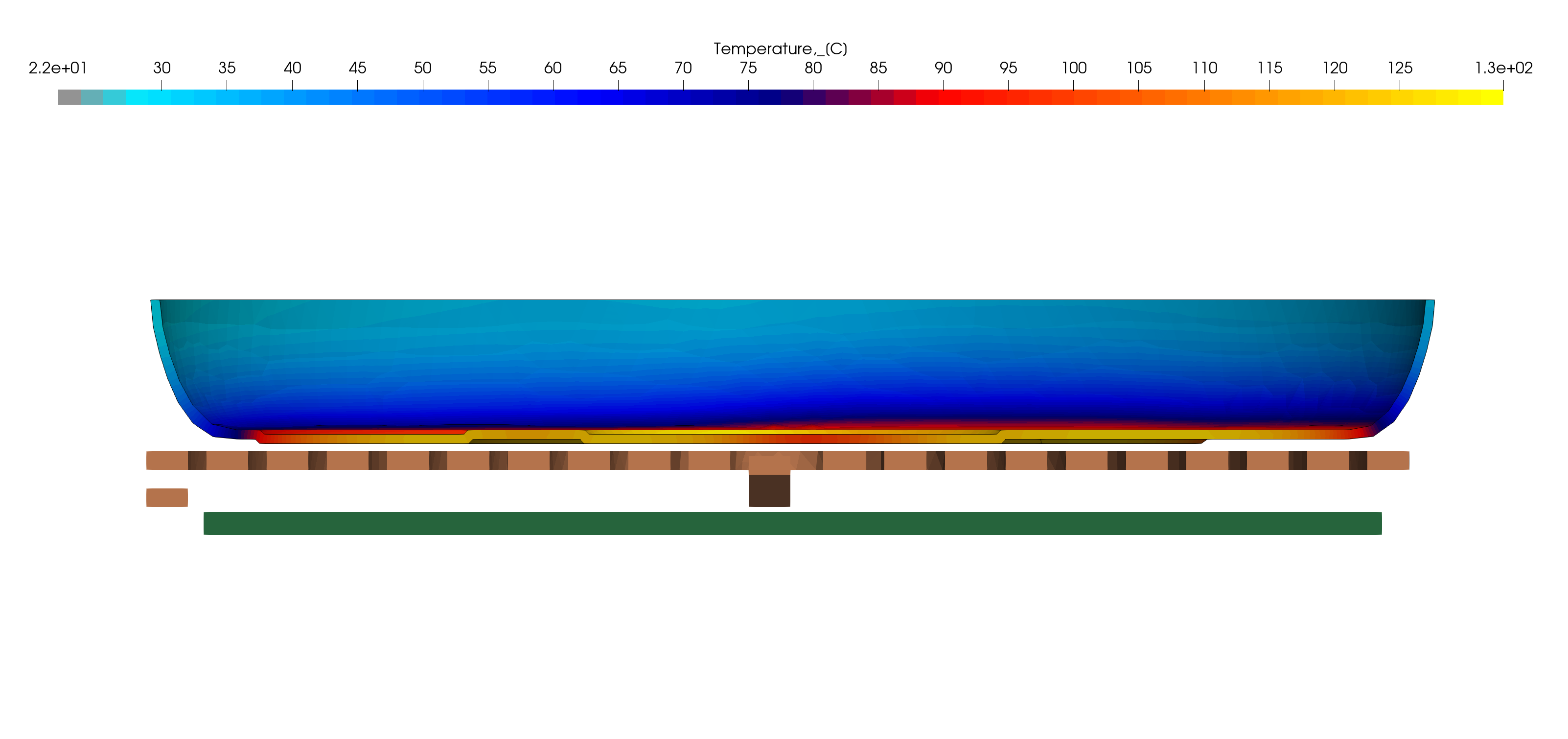
Magnetic field and magnetic flux simulation:
The magnetic field and flux interactions are important for understanding how well energy is transferred to the pan. In these simulations, the magnetic field is represented by lines and arrows, while the flux density is shown in color gradients.
- Magnetic flux density and field leakage: The magnetic flux density is strongest directly below the center of the pan, where the coil is most concentrated. However, there is noticeable flux leakage around the edges, where the arrows suggest magnetic energy is dispersing into the surrounding air, instead of being focused on the pan’s base. This inefficiency could lead to energy loss and uneven heating. The leakage is especially seen at the edges, which shows an opportunity for design improvement.
To improve efficiency, engineers should focus on redesigning the coil to minimize flux leakage, thereby concentrating more of the magnetic energy on the pan’s center and ensuring that more heat is generated where it is needed.
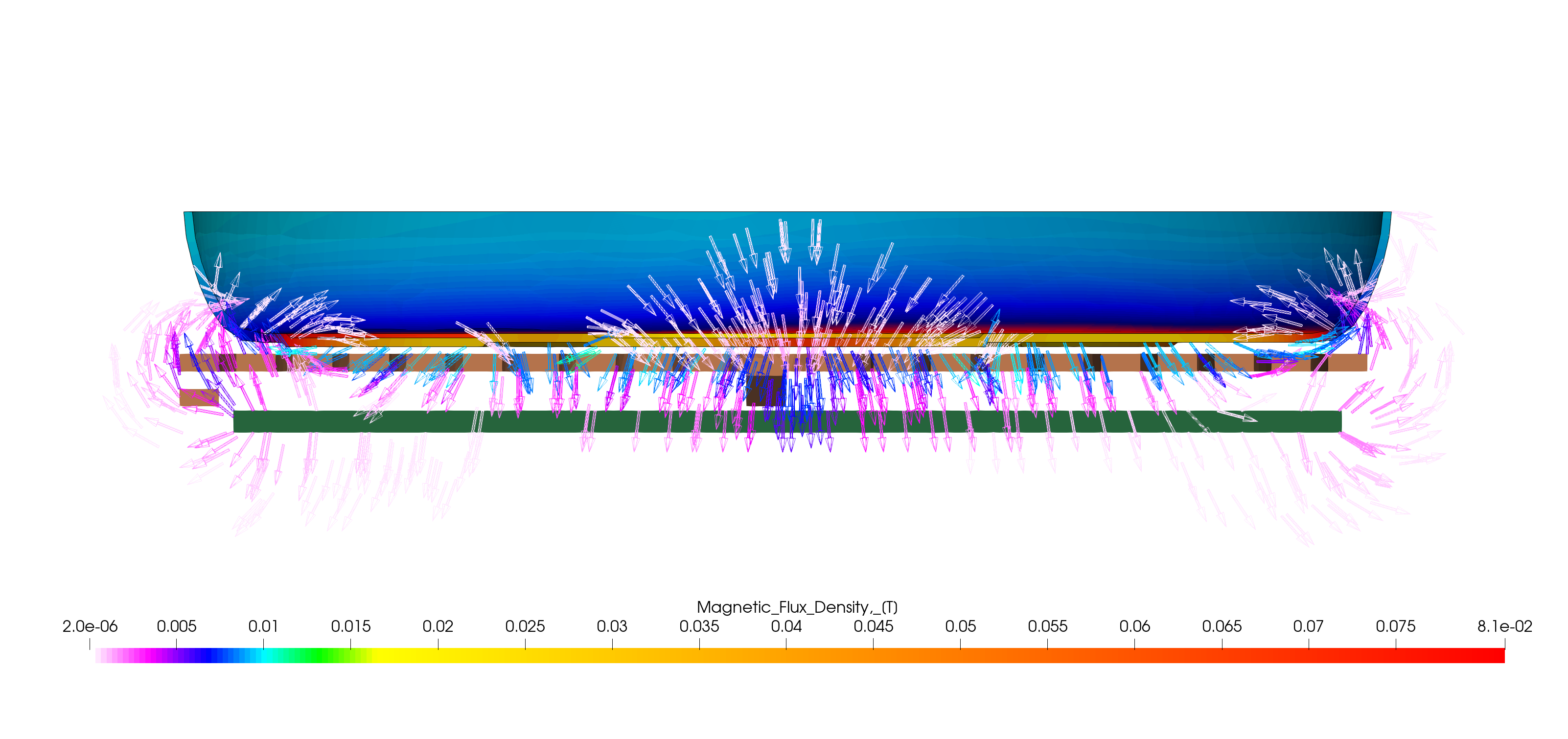
- Magnetic field lines and field efficiency: This image visualizes the flow of the magnetic field lines, showing where the field is most concentrated and where it splits. The field lines are densely packed beneath the pan, indicating a strong magnetic field. However, similar to the previous image, there is a significant amount of field separation toward the outer edges, with many lines “escaping” into the air. This shows us that while there is a strong magnetic field present, much of it is not being used efficiently to heat the pan.
The areas where the magnetic field lines spread outward and escape without interacting with the pan are potential points of inefficiency. In these regions, energy is wasted as it does not contribute to heating the pan’s base.
Reducing the magnetic fields going in different directions and focusing the field lines more directly under the pan could drastically improve heating efficiency. Engineers could explore reshaping the coil design or adding magnetic shielding to better direct the field.
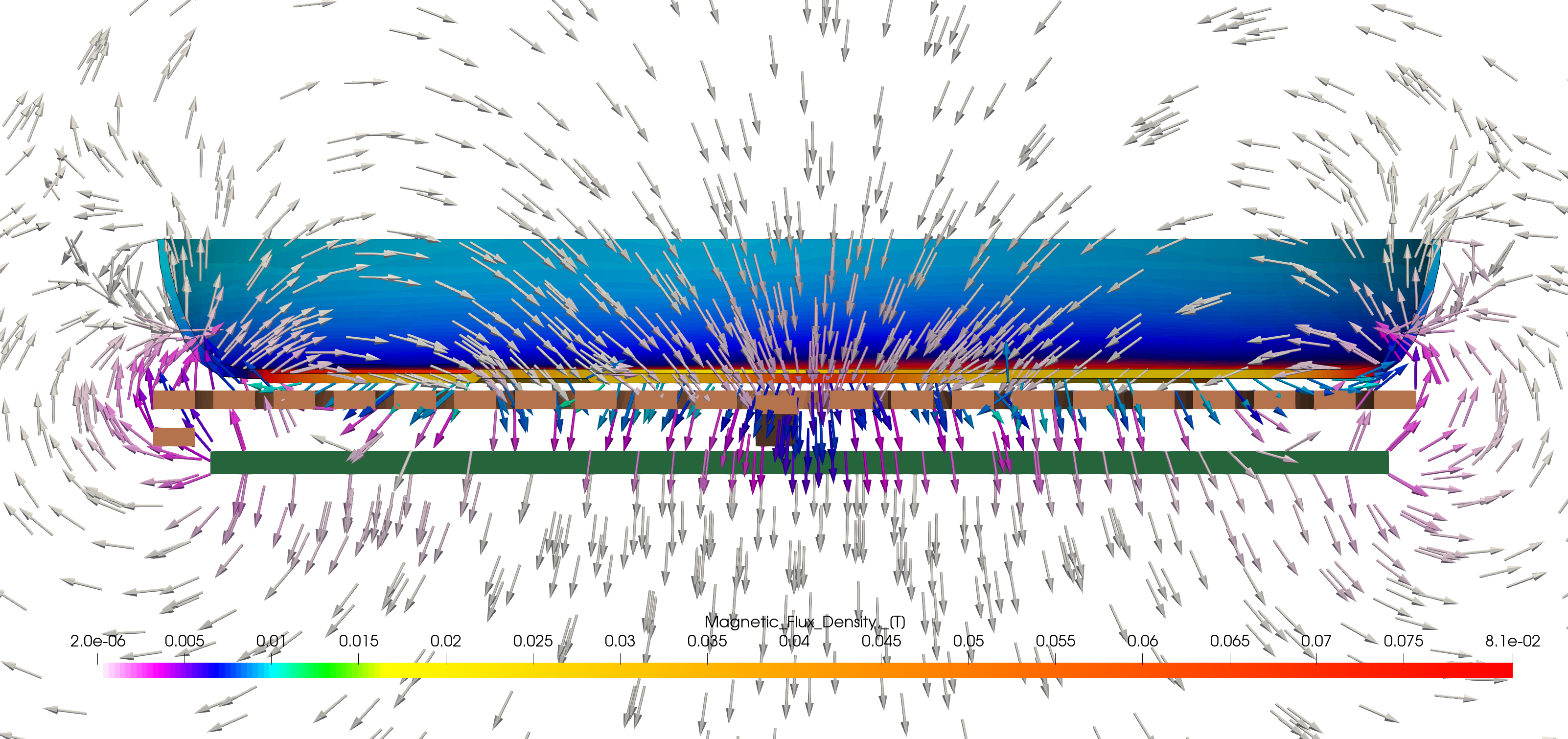
Coil design simulation:
The coil design is the base of the induction heating process. For accuracy in simulation, engineers often simplify the visualization of complex coils. Typically, coils are made of multiple individual strands (such as Litz wire) to reduce energy loss and improve efficiency.
- Coil and pan base interaction: The coil’s circular arrangement generates a heat pattern that’s denser at certain points, specifically near the center and inner rings of the pan. However, the outer edges of the pan remain relatively cooler, as shown by the blue areas, suggesting that the coil design is not efficiently transferring heat to the entire base. This indicates a need for optimization in how the coil covers the pan to ensure uniform heating.
Engineers could improve the design by exploring different coil configurations that allow for more even heat distribution. Increasing the density of the coil windings near the pan’s edges or reshaping the coil could address these cooler regions.
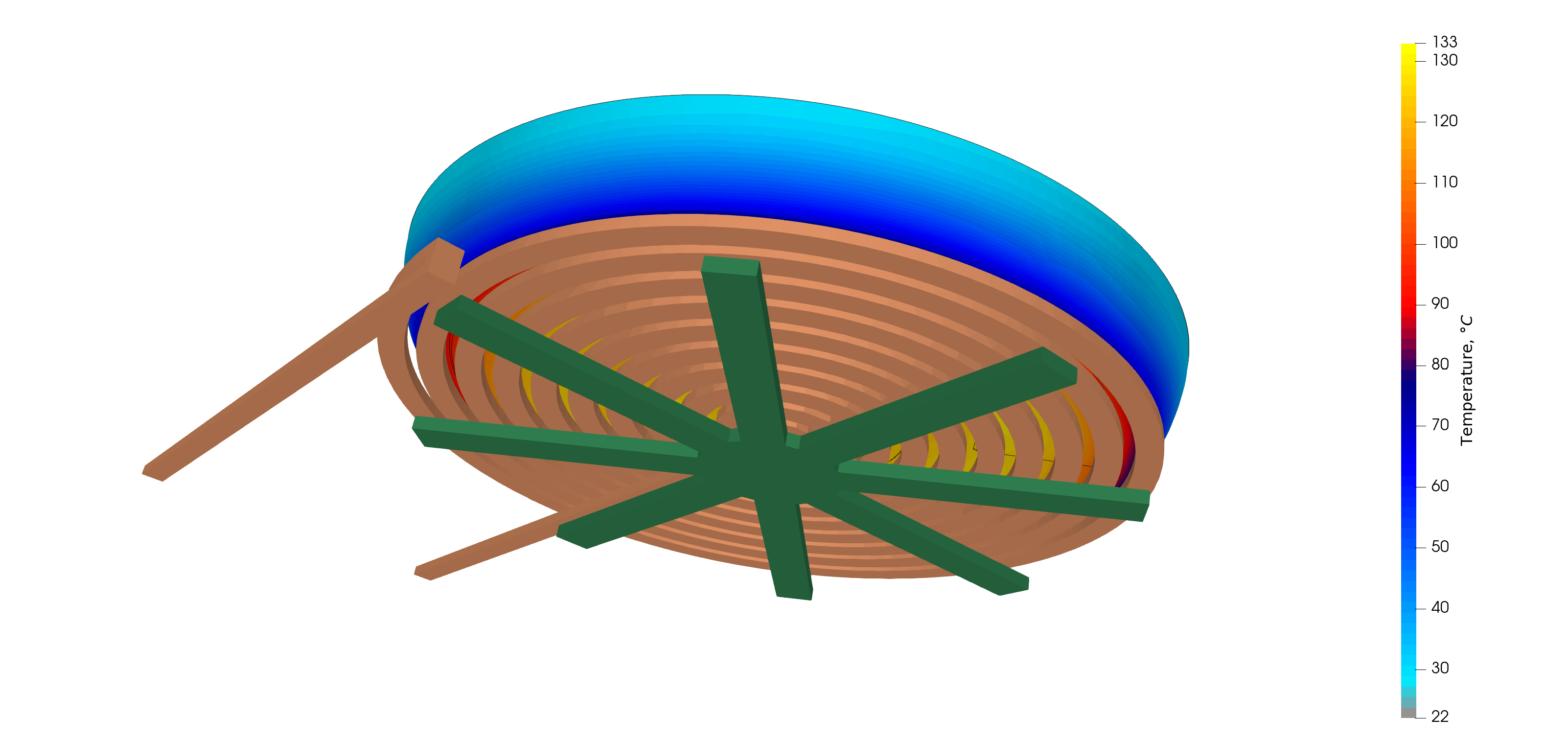
- Simplified coil representation: To simplify the simulation, engineers represent complex multi-strand coils as a single strand. However, in real-world designs, Litz wire—comprising multiple smaller strands—is used to minimize eddy current losses and ensure more efficient energy transfer. The simulation helps engineers understand how these wires can be arranged for optimal heat performance.
Engineers working with Litz wire could adjust the number of strands or even the placement of coil turns to improve the heating performance. A more optimized coil geometry that better matches the pan’s shape could lead to a more uniform temperature distribution across the entire surface.
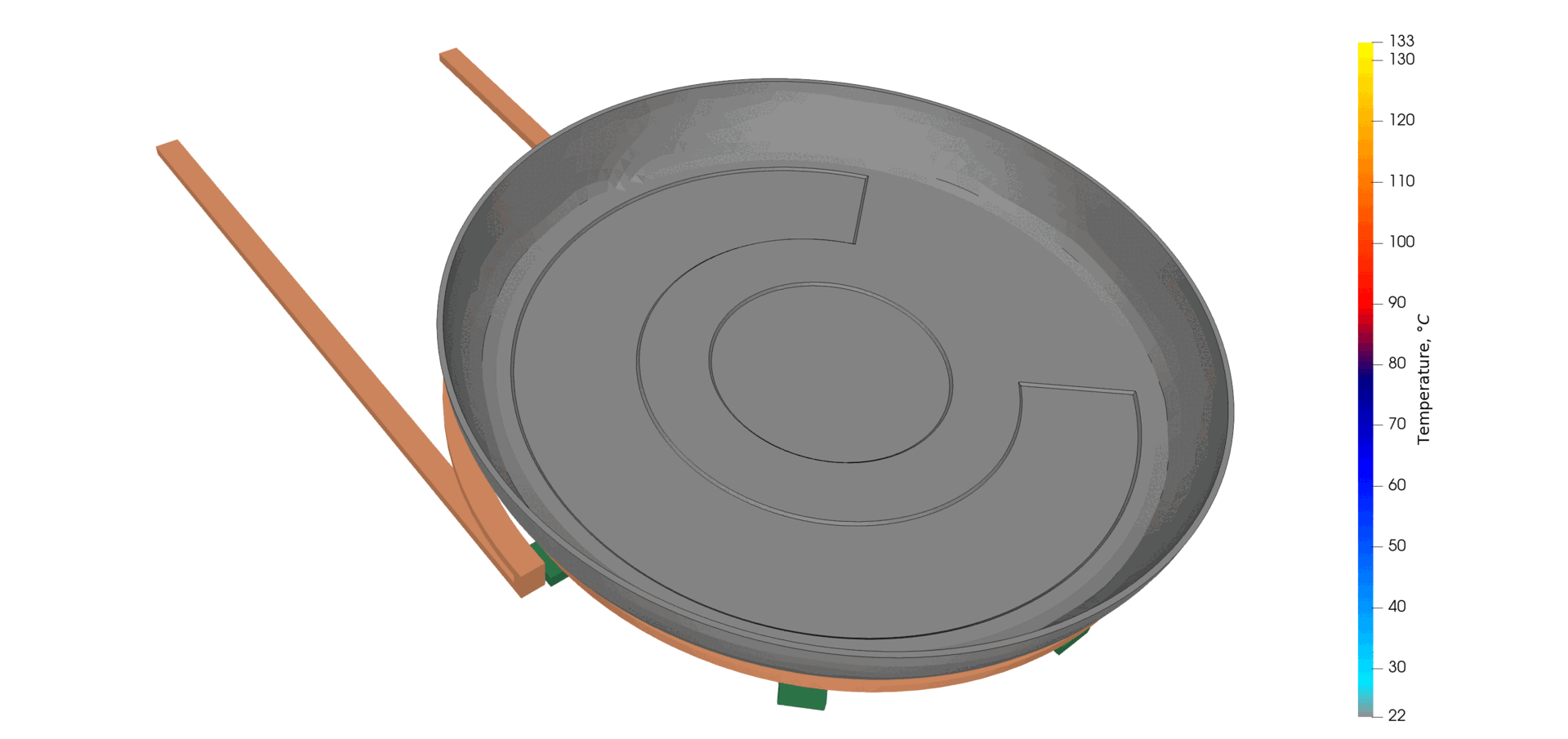
What is the result?
The final result of these simulations is a deeper understanding of how magnetic fields and coil design affect the performance of induction cooktops. These insights are important for engineers working to optimize efficiency and heat distribution.
- Coil and pan base design: These images from the simulation result clearly indicate that the design of both the coil and the pan’s base directly affects how well heat is distributed. There is a clear need to design coils that more effectively target the center of the pan to avoid inefficient heating.
- Material choices: The materials used in the pan also play a significant role. A combination of steel (for magnetic response) and aluminum (for heat conduction) seems promising but must be carefully balanced to avoid uneven heating.
- Engineering challenges: From the data, we see that solving these challenges will involve optimizing both the shape of the coil and the materials used in cookware. Multi-layer materials with different thermal and electromagnetic properties might offer a solution to improve energy transfer efficiency.
Temperature-Time diagram:
The chart attached shows the temperature progression over time at two points on the pan: the offset-middle (green line) and the center (red line). The offset-middle heats up faster and reaches a higher temperature than the center, indicating non-uniform heat distribution. This result is crucial for engineers aiming to achieve even cooking, as it highlights the need to focus on the pan’s central heating through optimized coil design and field management.
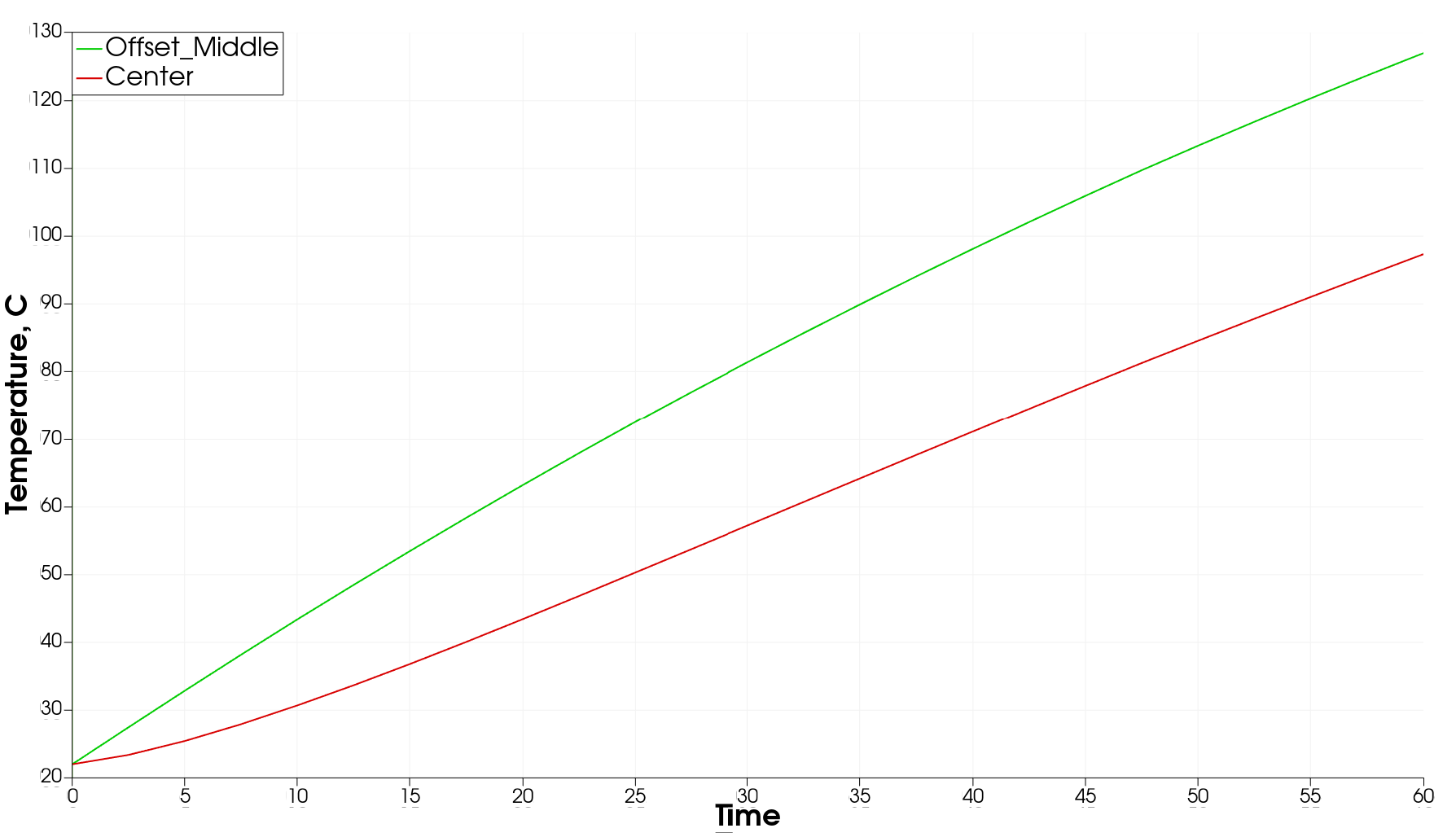
Why is this important?
By analyzing the simulation and the temperature-time diagram, engineers can identify key inefficiencies in the heating process. These simulations show where energy is lost, where heat is concentrated, and where the design can be improved to ensure more efficient energy transfer and uniform heat distribution. This kind of data allows engineers to fine-tune both coil design and pan material, leading to more efficient, faster, and even cooking on induction cooktops.
Final thoughts
The key to optimizing induction cooking efficiency lies in improving both coil design and pan materials. Engineers are exploring the use of multi-layered materials, which can enhance the interaction between the electromagnetic field and the cookware. In some cases, adding conductive layers within the pan improves the induction process, allowing for faster and more even heating.
The problem isn’t just limited to material. The shape of the pan and the thickness of its base need careful consideration. A well-designed pan will distribute heat uniformly, preventing “hot spots” and energy loss. Engineers are also experimenting with varying coil structures to ensure that the electromagnetic field generated is stronger and more focused, further enhancing the heat transfer process.
The use of advanced simulation software in the development of induction heating technology is a valuable tool for engineers. Through these visualizations, engineers can pinpoint inefficiencies, experiment with new designs, and ultimately create more effective and energy-efficient induction cooktops and cookware. This process ensures that future iterations of induction technology provide users with superior performance while also reducing energy waste.

